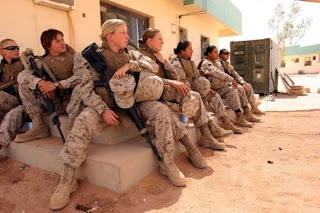This week's guest on Heroines of Fantasy is author, Sandra McDonald. Kim's post last week sparked some thoughts for her--and oh! What thoughts! I'll let her take it from here.
Back in college, my friend Tony had a poster on his dorm room wall of a scantily clad fantasy-novel babe, all chainmail and chains, her improbably beautiful golden hair a halo around her come-hither expression, lush red lips, and big round tits. She also was wielding a giant phallic sword. That poster was one of the reasons I wouldn't date him. You can see similar images just by typing "fantasy woman warriors" into your nearest image search engine. Regarding Kim Vandervort's recent post about scantily-clad cheerleaders, athletes and convention fans, I think it's important to realize that many real-life women and female characters are still trapped on Tony's wall, adorned and posed to please the male gaze. They just don't know it.
A few weeks later, I attended a Margaret Atwood reading at my local university. On the way to the correct auditorium I passed through the lobby of a national dance competition. Girls of all ages flitted about in glitter, heavy make-up and tight, often skimpy uniforms. Power? Confidence? Sure, they had it. But real power and real confidence, in this brave new age of the twentifirst century, would manifest in being able to compete without the feminine trappings. Not being trapped, as they were, in an athletic version of Toddlers and Tiaras.
That this dance contest was happening adjacent to Margaret Atwood's talk – Margaret Atwood, whose dystopian vision of The Handmaid's Tale is coming true with ever- increasing restrictions in our nation regarding women's reproductive rights – ah, cruel irony.
Why was Princess Leia Organa, a member of the Imperial Senate and hero of the resistance, a woman who had survived torture on the Death Star, thrown into a skimpy metal bikini for Return of the Jedi? It wasn't to show her power or intelligence. It wasn't part of her cunning plan to rescue Han Solo—the plot required her to fail. She was stripped of her sensible, would-be-rescuer costume in order to make the fanboys drool. Carrie Fischer is said to have not enjoyed filming those scenes, duct-taped as she was into metal, rubber and leather, nearly naked on a set crowded with men. I certainly didn't enjoy seeing it as a ten-foot wide poster in my local movie theater. This is what genre women have to look like, that poster screamed. That Leia strangles Jabba with her chain is a great moment, but the bikini itself was irrelevant to her success.
Jedi was the first step in my disenchantment with princesses, queens and warriors packaged up in prettiness and sensual costumes. I preferred Elizabeth Moon's The Deed of Paksenarrion and that great opening, with a young woman leaving home to join the army. (Check out the cover – there's a woman soldier for you!) Or Lois McMaster Bujold's Cordelia Naismith, battling the patriarchy in order to save her unborn, disabled baby. Or Nancy Kress's tales of Sleepers and Sleepless, Beggars in Spain, with Leisha Camden as a brainy heroine grappling with ethics. In fact, it took Kelly Link's awesome story Travels with the Snow Queen to lure me back into reading anything with "queen" in the title. Later I fell in love with Megan Whalen Turner's The Queen of Attolia, whose shocking punishment of a thief sets forth a story of redemption, transformation and love. Today I approach female characters in speculative fiction with a wary eye; I hope I write them in a balanced, sensible clothing kind of way.
Ugly women are feminine. Women who dress in sweatpants are feminine. Men who dress in women's clothing are feminine. Feminine is a set of behaviors associated with gender, but associated by who? Why? When my thirteen-year-old niece wears a midriff shirt with her underwear poking out, it's because she's been raised on a steady media diet of airbrushed bodies and faces, of a sexualized culture where looks must exceed talent. She doesn't burn her bra because she doesn't know she can. She doesn't know why she should. I need to take her to see Margaret Atwood.
It is my hope, in this brave new age of independent and digital publishing, that we'll embrace more definitions and examples of the feminine and move beyond The Warrior Babe. I hope that some day she can put down the phallus, don a sweater and some pants against the chill, and maybe even enjoy the novelty of flat shoes. But somewhere right now there's fanboy like Tony, tapping on his tablet in a dorm room. What do you think is on his wall?
Sandra McDonald is a former military officer and recovering Hollywood assistant. She is the author of five published books with two more on the way, and has more than fifty short stories in print. Her feminist, apocalyptic, gender-bending story Seven Sexy Cowboy Robots was recently named to the James A. Tiptree Award Honor List.








